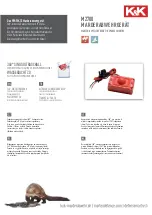
O.1.b. Fuel-Related Load Problems
•
Fuel problems when an engine is under load can cause engine damage quickly. The first check for
the fuel system is to look at the fuel pressure.
o
If the fuel pressure is dropping with load, there is a problem. Either the fuel pump cannot
keep up with the engine’s fuel needs, or the fuel pressure regulator is not functioning
properly. Fuel pressure should increase by 1psi with every 1psi of boost on turbo- or
supercharged engines (unless a rising rate regulator is installed).
o
If the fuel pressure is good, the injectors may be undersized. Go through
Section E.1
to
determine if injector sizing is a problem.
o
If the injectors are sized appropriately and the fuel pressure is adequate, it is likely a tuning
issue. Consult
Section B
.
•
Undesired EGO sensor corrections can contribute to fuel problems under load. Consult
Section
B.12
for EGO tuning recommendations.
O.1.c. Spark-Related Load Problems
•
Problems related to spark when under load can be traced to three factors: Tuning, Secondary
Ignition Failure, and Improper Wiring. Make sure the DFU’s are wired correctly before proceeding.
o
Tuning issues sometimes seem like spark-related problems. An engine that is detonating has
too much timing in the Ignition Advance Table, or is not receiving enough fuel. An engine
that is not performing well may have too little timing, or too much timing.
Try adding timing until detonation is detected, then back off a bit. Rotary engines do
not make a loud pinging sound, so
do not
attempt to run a rotary into detonation.
o
Secondary Ignition failure is often blamed for ignition problems under load. The secondary
ignition includes the spark plugs and spark plug wires.
Sections C.9
and
C.10
cover the
selection of spark plugs and wires.
Make sure the coil screws are very tight! Also, the DFU’s must be grounded for
proper operation.
If misfiring occurs under load, loose coil screws or ungrounded DFUs are often the
culprit.
P.1. Summary of Troubleshooting Topics
•
Make sure there is adequate fuel pressure at all times.
•
Make sure the crank trigger is installed properly.
•
Make sure the wiring is correct.
•
Make sure the DFUs are GROUNDED and that the coil screws are TIGHT.
•
Make sure that the engine sensors are reading correctly.
•
Make sure that the fuel injectors are firing, and are not clogged.
•
Check the fuses and relays if a power loss occurs.
Appendix I. Electromotive TECgt ECU Specifications
OUTPUTS
Fuel Injector Drivers
o
6 x 4.4/1.1 - 2.2/.5 amp peak-and-hold injector drivers
o
Up to 12 low or high impedance injectors can be driven
o
Low impedance injectors: 2 per driver (1 - 2.6
Ω
per driver)
______________________________________________________________________________________
TECgt Manual Version 2.0
- Page 114 -
©2008 Electromotive, Inc.
















































